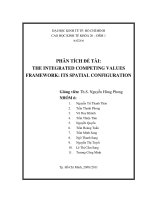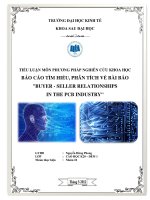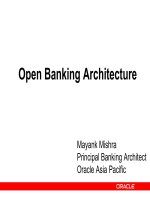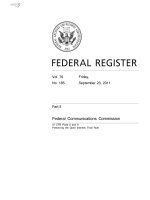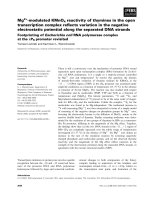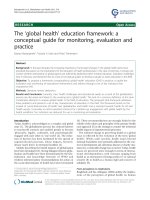The Open Group Architecture Framework 9
Bạn đang xem bản rút gọn của tài liệu. Xem và tải ngay bản đầy đủ của tài liệu tại đây (15.65 MB, 778 trang )
Personal PDF Edition
TOGAF Version 9
The Open Group Architecture Framework (TOGAF)
The Open Group
© 2009 The Open Group, All Rights Reserved
Personal PDF Edition. Not for redistribution
Personal PDF Edition
Copyright © 2009, The Open Group
All rights reserved.
No part of this publication may be reproduced, stored in a retrieval system, or transmitted, in any form or
by any means, electronic, mechanical, photocopying, recording or otherwise, without the prior permission
of the copyright owners.
TOGAF Version 9
The Open Group Architecture Framework (TOGAF)
ISBN: 978-90-8753-230-7
Document Number: G091
Published by The Open Group, 2009.
Any comments relating to the material contained in this document may be submitted by email to:
ii
TOGAF Version 9 (2009)
© 2009 The Open Group, All Rights Reserved
Personal PDF Edition. Not for redistribution
Personal PDF Edition
Contents
Part
I
Introduction ...............................................................................
1
Chapter
1
Introduction .................................................................................
3
3
5
1.1
1.2
Chapter
2
2.1
2.2
2.3
2.4
2.5
2.6
2.7
2.8
2.9
2.10
2.11
Structure of the TOGAF Document ................................................
Executive Overview ........................................................................
Core Concepts ............................................................................
What is TOGAF? ............................................................................
What is Architecture in the Context of TOGAF? .............................
What Kind of Architecture Does TOGAF Deal With?......................
Architecture Development Method .................................................
Deliverables, Artifacts, and Building Blocks ....................................
Enterprise Continuum .....................................................................
Architecture Repositor y ..................................................................
Establishing and Maintaining an Enterprise
Architecture Capability....................................................................
Establishing the Architecture Capability as an
Operational Entity ...........................................................................
Using TOGAF with Other Frameworks ...........................................
TOGAF Document Categorization Model .......................................
9
9
9
10
10
11
13
14
16
17
18
18
Chapter
3
Definitions .................................................................................... 23
Chapter
4
Release Notes ............................................................................. 41
4.1
4.2
4.3
4.4
4.5
4.5.1
4.5.2
4.5.3
4.6
What’s New in TOGAF 9?...............................................................
The Benefits of TOGAF 9 ...............................................................
Mapping of the TOGAF 8.1.1 Structure to TOGAF 9......................
Mapping of TOGAF 9 Structure to TOGAF 8.1.1............................
Using TOGAF .................................................................................
Conditions of Use ........................................................................
How Much Does TOGAF Cost?...................................................
Downloads ...................................................................................
Why Join The Open Group? ...........................................................
41
43
44
45
47
47
47
47
48
49
Part
II
Architecture Development Method (ADM)................
Chapter
5
Introduction ................................................................................. 51
5.1
5.1.1
5.1.2
ADM Over view................................................................................
The ADM, Enterprise Continuum, and Architecture
Repositor y ...................................................................................
The ADM and the Foundation Architecture .................................
The Open Group Architecture Framework (TOGAF)
© 2009 The Open Group, All Rights Reserved
Personal PDF Edition. Not for redistribution
51
51
52
iii
Personal PDF Edition
Contents
5.1.3
5.2
5.2.1
5.2.2
5.3
5.4
5.5
5.5.1
5.5.2
5.5.3
5.5.4
5.6
5.7
Chapter
6
6.1
6.2
6.2.1
6.2.2
6.2.3
6.2.4
6.2.5
6.2.6
6.2.7
6.3
6.3.1
6.3.2
6.3.3
6.4
6.4.1
6.4.2
6.4.3
6.4.4
6.4.5
6.4.6
6.5
Chapter
7
7.1
7.2
7.2.1
7.2.2
7.2.3
7.3
7.3.1
7.3.2
7.3.3
7.4
ADM and Supporting Guidelines and Techniques .......................
Architecture Development Cycle ....................................................
Key Points ....................................................................................
Basic Structure ............................................................................
Adapting the ADM ..........................................................................
Architecture Governance ................................................................
Scoping the Architecture ................................................................
Enterprise Scope/Focus ..............................................................
Architecture Domains ..................................................................
Ver tical Scope/Level of Detail ......................................................
Time Period .................................................................................
Architecture Integration ..................................................................
Summary ........................................................................................
52
53
53
53
56
57
58
60
61
61
62
63
65
Preliminary Phase ..................................................................... 67
Objectives .......................................................................................
Approach ........................................................................................
Enterprise ....................................................................................
Organizational Context ................................................................
Requirements for Architecture Work............................................
Principles .....................................................................................
Management Frameworks ...........................................................
Relating the Management Frameworks.......................................
Planning for Enter prise Architecture/Business
Change Maturity Evaluation ........................................................
Inputs..............................................................................................
Reference Materials External to the Enterprise...........................
Non-Architectural Inputs ..............................................................
Architectural Inputs......................................................................
Steps ..............................................................................................
Scope the Enterprise Organizations Impacted............................
Confirm Governance and Support Frameworks ..........................
Define and Establish Enterprise Architecture Team
and Organization .........................................................................
Identify and Establish Architecture Principles ..............................
Select and Tailor Architecture Framework(s) ...............................
Implement Architecture Tools ......................................................
Outputs ...........................................................................................
68
68
69
70
71
71
71
73
74
75
75
75
75
76
76
77
77
78
78
78
79
Phase A: Architecture Vision ............................................... 81
Objectives .......................................................................................
Approach ........................................................................................
General ........................................................................................
Creating the Architecture Vision ..................................................
Business Scenarios .....................................................................
Inputs..............................................................................................
Reference Materials External to the Enterprise...........................
Non-Architectural Inputs ..............................................................
Architectural Inputs......................................................................
Steps ..............................................................................................
iv
82
82
82
83
84
84
84
84
84
85
TOGAF Version 9 (2009)
© 2009 The Open Group, All Rights Reserved
Personal PDF Edition. Not for redistribution
Personal PDF Edition
Contents
7.4.1
7.4.2
7.4.3
7.4.4
7.4.5
7.4.6
7.4.7
7.4.8
7.4.9
7.4.10
7.4.11
7.5
Chapter
8
8.1
8.2
8.2.1
8.2.2
8.2.3
8.2.4
8.3
8.3.1
8.3.2
8.3.3
8.4
8.4.1
8.4.2
8.4.3
8.4.4
8.4.5
8.4.6
8.4.7
8.4.8
8.4.9
8.5
Chapter
9
9.1
9.2
9.2.1
9.2.2
9.3
9.3.1
Establish the Architecture Project................................................
Identify Stakeholders, Concerns, and Business
Requirements ..............................................................................
Confirm and Elaborate Business Goals, Business
Drivers, and Constraints ..............................................................
Evaluate Business Capabilities ...................................................
Assess Readiness for Business Transformation..........................
Define Scope ...............................................................................
Confirm and Elaborate Architecture Principles,
including Business Principles ......................................................
Develop Architecture Vision.........................................................
Define the Target Architecture Value Propositions
and KPIs ......................................................................................
Identify the Business Transformation Risks and
Mitigation Activities ......................................................................
Develop Enterprise Architecture Plans and
Statement of Architecture Work; Secure Approval ......................
Outputs ...........................................................................................
86
86
87
87
87
88
88
88
89
89
89
90
Phase B: Business Architecture ......................................... 93
Objectives .......................................................................................
Approach ........................................................................................
General ........................................................................................
Developing the Baseline Description ...........................................
Business Modeling ......................................................................
Architecture Repositor y ...............................................................
Inputs..............................................................................................
Reference Materials External to the Enterprise...........................
Non-Architectural Inputs ..............................................................
Architectural Inputs......................................................................
Steps ..............................................................................................
Select Reference Models, Viewpoints, and Tools ........................
Develop Baseline Business Architecture
Description...................................................................................
Develop Target Business Architecture Description ......................
Perform Gap Analysis..................................................................
Define Roadmap Components ....................................................
Resolve Impacts Across the Architecture Landscape .................
Conduct Formal Stakeholder Review ..........................................
Finalize the Business Architecture ..............................................
Create Architecture Definition Document ....................................
Outputs ...........................................................................................
94
94
94
95
95
97
98
98
98
98
100
100
103
104
104
104
105
105
105
106
106
Phase C: Information Systems Architectures ............... 109
Objectives .......................................................................................
Approach ........................................................................................
Development................................................................................
Implementation ............................................................................
Inputs..............................................................................................
Reference Materials External to the Enterprise...........................
The Open Group Architecture Framework (TOGAF)
© 2009 The Open Group, All Rights Reserved
Personal PDF Edition. Not for redistribution
110
110
110
110
111
111
v
Personal PDF Edition
Contents
9.3.2
9.3.3
9.4
9.5
Chapter
10
10.1
10.2
10.2.1
10.2.2
10.3
10.3.1
10.3.2
10.3.3
10.4
10.4.1
10.4.2
10.4.3
10.4.4
10.4.5
10.4.6
10.4.7
10.4.8
10.4.9
10.5
Chapter
11
11.1
11.2
11.2.1
11.3
11.3.1
11.3.2
11.3.3
11.4
11.4.1
11.4.2
11.4.3
11.4.4
11.4.5
11.4.6
11.4.7
11.4.8
11.4.9
11.5
Non-Architectural Inputs ..............................................................
Architectural Inputs......................................................................
Steps ..............................................................................................
Outputs ...........................................................................................
111
111
112
112
Phase C: Information Systems Architectures —
Data Architecture ....................................................................... 115
Objectives .......................................................................................
Approach ........................................................................................
Key Considerations for Data Architecture....................................
Architecture Repositor y ...............................................................
Inputs..............................................................................................
Reference Materials External to the Enterprise...........................
Non-Architectural Inputs ..............................................................
Architectural Inputs......................................................................
Steps ..............................................................................................
Select Reference Models, Viewpoints, and Tools ........................
Develop Baseline Data Architecture Description .........................
Develop Target Data Architecture Description .............................
Perform Gap Analysis..................................................................
Define Roadmap Components ....................................................
Resolve Impacts Across the Architecture Landscape .................
Conduct Formal Stakeholder Review ..........................................
Finalize the Data Architecture .....................................................
Create Architecture Definition Document ....................................
Outputs ...........................................................................................
115
115
115
116
117
117
117
117
118
119
122
122
122
123
123
123
124
124
125
Phase C: Information Systems Architectures —
Application Architecture......................................................... 127
Objectives .......................................................................................
Approach ........................................................................................
Architecture Repositor y ...............................................................
Inputs..............................................................................................
Reference Materials External to the Enterprise...........................
Non-Architectural Inputs ..............................................................
Architectural Inputs......................................................................
Steps ..............................................................................................
Select Reference Models, Viewpoints, and Tools ........................
Develop Baseline Application Architecture
Description...................................................................................
Develop Target Application Architecture
Description...................................................................................
Perform Gap Analysis..................................................................
Define Roadmap Components ....................................................
Resolve Impacts Across the Architecture Landscape .................
Conduct Formal Stakeholder Review ..........................................
Finalize the Application Architecture ...........................................
Create Architecture Definition Document ....................................
Outputs ...........................................................................................
vi
127
127
127
128
128
128
128
129
130
133
134
134
134
135
135
135
136
136
TOGAF Version 9 (2009)
© 2009 The Open Group, All Rights Reserved
Personal PDF Edition. Not for redistribution
Personal PDF Edition
Contents
Chapter
12
12.1
12.2
12.2.1
12.3
12.3.1
12.3.2
12.3.3
12.4
12.4.1
12.4.2
12.4.3
12.4.4
12.4.5
12.4.6
12.4.7
12.4.8
12.4.9
12.5
12.6
Chapter
13
13.1
13.2
13.3
13.3.1
13.3.2
13.3.3
13.4
13.4.1
13.4.2
13.4.3
13.4.4
13.4.5
13.4.6
13.4.7
13.4.8
13.4.9
13.4.10
13.4.11
13.5
Phase D: Technology Architecture .................................... 137
Objectives .......................................................................................
Approach ........................................................................................
Architecture Repositor y ...............................................................
Inputs..............................................................................................
Reference Materials External to the Enterprise...........................
Non-Architectural Inputs ..............................................................
Architectural Inputs......................................................................
Steps ..............................................................................................
Select Reference Models, Viewpoints, and Tools ........................
Develop Baseline Technology Architecture
Description...................................................................................
Develop Target Technology Architecture
Description...................................................................................
Perform Gap Analysis..................................................................
Define Roadmap Components ....................................................
Resolve Impacts Across the Architecture Landscape .................
Conduct Formal Stakeholder Review ..........................................
Finalize the Technology Architecture ...........................................
Create Architecture Definition Document ....................................
Outputs ...........................................................................................
Postscript ........................................................................................
138
138
138
139
139
139
139
140
141
145
145
146
146
146
147
147
147
148
148
Phase E: Opportunities & Solutions.................................. 149
Objectives .......................................................................................
Approach ........................................................................................
Inputs..............................................................................................
Reference Materials External to the Enterprise...........................
Non-Architectural Inputs ..............................................................
Architectural Inputs......................................................................
Steps ..............................................................................................
Determine/Confirm Key Cor porate Change Attributes ................
Determine Business Constraints for Implementation ..................
Review and Consolidate Gap Analysis Results from
Phases B to D..............................................................................
Review IT Requirements from a Functional
Perspective ..................................................................................
Consolidate and Reconcile Interoperability
Requirements ..............................................................................
Refine and Validate Dependencies .............................................
Confirm Readiness and Risk for Business
Transformation .............................................................................
Formulate High-Level Implementation and Migration
Strategy .......................................................................................
Identify and Group Major Work Packages ...................................
Identify Transition Architectures...................................................
Create Portfolio and Project Charters and Update
the Architectures..........................................................................
Outputs ...........................................................................................
The Open Group Architecture Framework (TOGAF)
© 2009 The Open Group, All Rights Reserved
Personal PDF Edition. Not for redistribution
150
150
152
152
152
152
153
154
155
156
157
158
158
160
161
162
164
165
166
vii
Personal PDF Edition
Contents
Chapter
14
14.1
14.2
14.3
14.3.1
14.3.2
14.3.3
14.4
14.4.1
14.4.2
14.4.3
14.4.4
14.4.5
14.4.6
14.4.7
14.5
Chapter
15
15.1
15.2
15.3
15.3.1
15.3.2
15.3.3
15.4
15.4.1
15.4.2
15.4.3
15.4.4
15.4.5
15.4.6
15.5
Chapter
16
16.1
16.2
16.2.1
16.2.2
16.2.3
Phase F: Migration Planning................................................. 167
Objectives .......................................................................................
Approach ........................................................................................
Inputs..............................................................................................
Reference Materials External to the Enterprise...........................
Non-Architectural Inputs ..............................................................
Architectural Inputs......................................................................
Steps ..............................................................................................
Confirm Management Framework Interactions for
Implementation and Migration Plan .............................................
Assign a Business Value to Each Project....................................
Estimate Resource Requirements, Project Timings,
and Availability/Deliver y Vehicles ................................................
Prioritize the Migration Projects through the
Conduct of a Cost/Benefit Assessment and Risk
Validation .....................................................................................
Confirm Transition Architecture Increments/Phases
and Update Architecture Definition Document ............................
Generate the Architecture Implementation Roadmap
(Time-Lined) and Migration Plan .................................................
Establish the Architecture Evolution Cycle and
Document Lessons Learned .......................................................
Outputs ...........................................................................................
168
168
169
169
169
169
171
171
174
176
177
179
180
182
183
Phase G: Implementation Governance ............................. 185
Objectives .......................................................................................
Approach ........................................................................................
Inputs..............................................................................................
Reference Materials External to the Enterprise...........................
Non-Architectural Inputs ..............................................................
Architectural Inputs......................................................................
Steps ..............................................................................................
Confirm Scope and Priorities for Deployment with
Development Management..........................................................
Identify Deployment Resources and Skills ..................................
Guide Development of Solutions Deployment .............................
Perform Enter prise Architecture Compliance
Reviews .......................................................................................
Implement Business and IT Operations ......................................
Perform Post-Implementation Review and Close the
Implementation ............................................................................
Outputs ...........................................................................................
186
186
187
187
187
187
188
189
189
189
190
190
190
191
Phase H: Architecture Change Management ................. 193
Objectives .......................................................................................
Approach ........................................................................................
Drivers for Change.......................................................................
Enterprise Architecture Change Management Process ..............
Guidelines for Maintenance versus Architecture
Redesign .....................................................................................
viii
194
194
195
196
197
TOGAF Version 9 (2009)
© 2009 The Open Group, All Rights Reserved
Personal PDF Edition. Not for redistribution
Personal PDF Edition
Contents
16.3
16.3.1
16.3.2
16.3.3
16.4
16.4.1
16.4.2
16.4.3
16.4.4
16.4.5
16.4.6
16.4.7
16.5
Chapter
17
17.1
17.2
17.2.1
17.2.2
17.3
17.4
17.5
Inputs..............................................................................................
Reference Materials External to the Enterprise...........................
Non-Architectural Inputs ..............................................................
Architectural Inputs......................................................................
Steps ..............................................................................................
Establish Value Realization Process ...........................................
Deploy Monitoring Tools ..............................................................
Manage Risks ..............................................................................
Provide Analysis for Architecture Change
Management................................................................................
Develop Change Requirements to Meet Performance
Targets .........................................................................................
Manage Governance Process .....................................................
Activate the Process to Implement Change ................................
Outputs ...........................................................................................
198
198
198
198
200
200
200
201
201
201
201
201
202
ADM Architecture Requirements Management ............. 203
Objectives .......................................................................................
Approach ........................................................................................
General ........................................................................................
Resources ...................................................................................
Inputs..............................................................................................
Steps ..............................................................................................
Outputs ...........................................................................................
204
204
204
204
205
206
209
211
Part
III
ADM Guidelines and Techniques ..................................
Chapter
18
Introduction ................................................................................. 213
18.1
18.2
Chapter
19
19.1
19.2
19.3
19.4
Chapter
20
20.1
20.2
20.3
20.4
20.4.1
20.4.2
Chapter
21
21.1
21.2
21.3
Guidelines for Adapting the ADM Process ..................................... 213
Techniques for Architecture Development ...................................... 213
Applying Iteration to the ADM .............................................. 215
Over view.........................................................................................
Iteration Cycles...............................................................................
Two Styles of Architecture Definition ..............................................
Mapping TOGAF Phases to Iteration Cycles..................................
215
216
217
218
Applying the ADM at Different Enterprise Levels ........ 223
Over view.........................................................................................
Classes of Architecture Engagement .............................................
Developing Architectures at Different Levels ..................................
ADM Cycle Approaches .................................................................
Using Iterations within a Single ADM Cycle ................................
Using a Hierarchy of ADM Processes .........................................
223
224
227
227
227
229
Security Architecture and the ADM ................................... 231
Over view......................................................................................... 231
Introduction..................................................................................... 231
Guidance on Security for the Architecture Domains....................... 232
The Open Group Architecture Framework (TOGAF)
© 2009 The Open Group, All Rights Reserved
Personal PDF Edition. Not for redistribution
ix
Personal PDF Edition
Contents
21.4
21.5
21.5.1
21.5.2
21.6
21.6.1
21.6.2
21.7
21.7.1
21.7.2
21.8
21.8.1
21.8.2
21.9
21.9.1
21.9.2
21.10
21.11
21.12
21.13
21.14
Chapter
22
22.1
22.2
22.3
22.4
22.5
22.6
22.7
22.8
22.8.1
22.8.2
22.8.3
22.9
22.10
Chapter
23
23.1
23.2
23.3
23.4
23.4.1
23.5
23.6
23.6.1
23.6.2
23.6.3
23.6.4
ADM Architecture Requirements Management ..............................
Preliminary Phase ..........................................................................
Security Inputs.............................................................................
Security Outputs ..........................................................................
Phase A: Architecture Vision ..........................................................
Security Inputs.............................................................................
Security Outputs ..........................................................................
Phase B: Business Architecture .....................................................
Security Inputs.............................................................................
Security Outputs ..........................................................................
Phase C: Information Systems Architectures .................................
Security Inputs.............................................................................
Security Outputs ..........................................................................
Phase D: Technology Architecture .................................................
Security Inputs.............................................................................
Security Outputs ..........................................................................
Phase E: Opportunities & Solutions ...............................................
Phase F: Migration Planning ..........................................................
Phase G: Implementation Governance ..........................................
Phase H: Architecture Change Management .................................
References .....................................................................................
233
234
235
235
235
237
237
237
239
240
240
242
243
243
244
245
245
246
246
247
248
Using TOGAF to Define & Govern SOAs ......................... 249
Over view.........................................................................................
Introduction.....................................................................................
Business-Led SOA Community ......................................................
Business- & Developer-Led SOA Communities..............................
Complexities Arising from SOA ......................................................
How Enter prise Architecture Supports SOA...................................
SOA and TOGAF ............................................................................
Guidelines for Ser vice Contract Definition......................................
Service Qualities and TOGAF .....................................................
Purpose of a Service Contract ....................................................
Service Governance Considerations ...........................................
Content and Structure of a Service Contract ..................................
Service Contract Template .............................................................
249
249
250
250
252
253
254
258
258
258
259
261
262
Architecture Principles ........................................................... 265
Introduction.....................................................................................
Characteristics of Architecture Principles .......................................
Components of Architecture Principles ..........................................
Developing Architecture Principles .................................................
Qualities of Principles ..................................................................
Applying Architecture Principles .....................................................
Example Set of Architecture Principles ..........................................
Business Principles .....................................................................
Data Principles ............................................................................
Application Principles ..................................................................
Technology Principles ..................................................................
x
265
266
266
267
267
268
269
269
273
278
279
TOGAF Version 9 (2009)
© 2009 The Open Group, All Rights Reserved
Personal PDF Edition. Not for redistribution
Personal PDF Edition
Contents
Chapter
24
24.1
24.2
24.3
24.3.1
24.3.2
24.3.3
24.3.4
24.4
Chapter
25
25.1
25.1.1
25.1.2
25.1.3
25.1.4
25.2
25.2.1
25.2.2
25.3
25.4
Chapter
26
26.1
26.2
26.3
26.3.1
26.3.2
26.3.3
26.3.4
26.4
26.5
26.6
26.7
26.7.1
26.7.2
26.8
26.8.1
26.8.2
26.9
26.9.1
26.9.2
26.9.3
26.10
Chapter
27
27.1
27.2
27.3
Stakeholder Management ...................................................... 281
Introduction.....................................................................................
Approach to Stakeholder Management ..........................................
Steps in the Stakeholder Management Process ............................
Identify Stakeholders ...................................................................
Classify Stakeholder Positions ....................................................
Determine Stakeholder Management Approach .........................
Tailor Engagement Deliverables ..................................................
Template Stakeholder Map .............................................................
281
282
282
282
284
285
286
286
Architecture Patterns ............................................................... 293
Introduction.....................................................................................
Background .................................................................................
Content of a Pattern ....................................................................
Terminology .................................................................................
Architecture Patterns in Use........................................................
US Treasur y Architecture Development Guidance (TADG) ............
TADG Pattern Content .................................................................
TADG Architecture Patterns ........................................................
IBM Patterns for e-Business ...........................................................
Some Pattern Resources ...............................................................
293
293
294
295
296
297
297
298
298
300
Business Scenarios.................................................................. 301
Introduction.....................................................................................
Benefits of Business Scenarios ......................................................
Creating the Business Scenario .....................................................
Overall Process ...........................................................................
Gathering .....................................................................................
Analyzing .....................................................................................
Reviewing ....................................................................................
Contents of a Business Scenario ...................................................
Contributions to the Business Scenario..........................................
Business Scenarios and the TOGAF ADM.....................................
Guidelines on Developing Business Scenarios ..............................
General Guidelines......................................................................
Questions to Ask for Each Area ..................................................
Guidelines on Business Scenario Documentation..........................
Textual Documentation ................................................................
Business Scenario Models ..........................................................
Guidelines on Goals and Objectives ..............................................
Importance of Goals ....................................................................
Importance of SMART Objectives ...............................................
Categories of Goals and Objectives ............................................
Summary ........................................................................................
301
302
302
302
304
305
305
306
308
308
310
310
310
312
312
313
313
313
313
315
319
Gap Analysis ............................................................................... 321
Introduction..................................................................................... 321
Suggested Steps ............................................................................ 322
Example.......................................................................................... 322
The Open Group Architecture Framework (TOGAF)
© 2009 The Open Group, All Rights Reserved
Personal PDF Edition. Not for redistribution
xi
Personal PDF Edition
Contents
Chapter
28
28.1
28.2
28.3
28.4
28.5
Chapter
29
29.1
29.2
29.3
29.4
29.5
29.6
29.7
Chapter
30
30.1
30.1.1
30.2
30.3
30.4
30.4.1
30.4.2
30.4.3
30.5
30.6
30.7
Chapter
31
31.1
31.2
31.3
31.4
31.5
31.6
31.7
31.8
Chapter
32
32.1
32.2
32.3
32.3.1
32.3.2
32.4
32.5
Migration Planning Techniques ........................................... 325
Implementation Factor Assessment and Deduction
Matrix..............................................................................................
Consolidated Gaps, Solutions, and Dependencies
Matrix..............................................................................................
Architecture Definition Increments Table ........................................
Enterprise Architecture State Evolution Table ................................
Business Value Assessment Technique .........................................
325
326
326
327
328
Interoperability Requirements ............................................. 329
Over view.........................................................................................
Defining Interoperability ..................................................................
Enterprise Operating Model ...........................................................
Refining Interoperability ..................................................................
Determining Interoperability Requirements ....................................
Reconciling Interoperability Requirements with
Potential Solutions ..........................................................................
Summary ........................................................................................
329
330
331
332
333
334
335
Business Transformation Readiness Assessment...... 337
Introduction.....................................................................................
Business Transformation Enablement Program (BTEP) ..............
Determine Readiness Factors ........................................................
Present Readiness Factors ............................................................
Assess Readiness Factors .............................................................
Readiness Factor Vision..............................................................
Readiness Factor Rating .............................................................
Readiness Factor Risks & Actions...............................................
Readiness and Migration Planning.................................................
Marketing the Implementation Plan ................................................
Conclusion......................................................................................
337
338
338
340
341
342
342
343
344
344
345
Risk Management ...................................................................... 347
Introduction.....................................................................................
Risk Classification ..........................................................................
Risk Identification ...........................................................................
Initial Risk Assessment...................................................................
Risk Mitigation and Residual Risk Assessment..............................
Conduct Residual Risk Assessment...............................................
Risk Monitoring and Governance (Phase G)..................................
Summary ........................................................................................
347
348
348
349
350
350
351
351
Capability-Based Planning .................................................... 353
Over view.........................................................................................
Capability-Based Planning Paradigm .............................................
Concept of Capability-Based Planning ...........................................
Capability Dimensions .................................................................
Capability Increments ..................................................................
Capabilities in an Enterprise Architecture Context .........................
Summary ........................................................................................
xii
353
354
354
355
356
357
358
TOGAF Version 9 (2009)
© 2009 The Open Group, All Rights Reserved
Personal PDF Edition. Not for redistribution
Personal PDF Edition
Contents
Part
IV
Architecture Content Framework ..................................
Chapter
33
Introduction ................................................................................. 361
Chapter
34
Content Metamodel................................................................... 367
34.1
34.2
34.2.1
34.2.2
34.3
34.3.1
34.3.2
34.3.3
34.4
34.4.1
34.4.2
34.4.3
34.4.4
34.4.5
34.4.6
34.5
34.6
34.7
Chapter
35
35.1
35.1.1
35.2
35.2.1
35.2.2
35.3
35.3.1
35.4
35.4.1
35.4.2
35.4.3
35.5
35.6
35.7
35.8
35.9
35.10
35.11
35.12
35.13
35.14
35.15
35.15.1
35.15.2
Over view.........................................................................................
Content Metamodel Vision and Concepts ......................................
Core Content Metamodel Concepts ............................................
Over view of the Content Metamodel ...........................................
Content Metamodel in Detail ..........................................................
Core Content Metamodel ............................................................
Core Architecture Artifacts...........................................................
Full Content Metamodel ..............................................................
Content Metamodel Extensions......................................................
Governance Extensions ..............................................................
Services Extensions ....................................................................
Process Modeling Extensions .....................................................
Data Extensions ..........................................................................
Infrastructure Consolidation Extensions ......................................
Motivation Extensions..................................................................
Content Metamodel Objects ...........................................................
Content Metamodel Attributes ........................................................
Metamodel Relationships ...............................................................
359
367
367
367
373
375
376
376
377
380
381
383
385
387
389
391
393
396
406
Architectural Artifacts ............................................................. 411
Basic Concepts...............................................................................
Simple Example of a Viewpoint and View ...................................
Developing Views in the ADM ........................................................
General Guidelines......................................................................
View Creation Process ................................................................
Views, Tools, and Languages .........................................................
Over view......................................................................................
Views and Viewpoints .....................................................................
Example of Views and Viewpoints ...............................................
Views and Viewpoints in Enterprise Architecture ........................
Need for a Common Language and Interoperable
Tools for Architecture Description ................................................
Conclusions ....................................................................................
Taxonomy of Architecture Viewpoints .............................................
Viewpoints in the Preliminary Phase ..............................................
Viewpoints in Phase A....................................................................
Viewpoints in Phase B....................................................................
Viewpoints in the Phase C Data Architecture .................................
Viewpoints in the Phase C Application Architecture .......................
Viewpoints in Phase D....................................................................
Viewpoints in Phase E....................................................................
Viewpoints for Requirements Management....................................
Developing a Business Architecture View ......................................
Stakeholders and Concerns ........................................................
Developing the View ....................................................................
The Open Group Architecture Framework (TOGAF)
© 2009 The Open Group, All Rights Reserved
Personal PDF Edition. Not for redistribution
411
413
414
414
415
416
416
416
416
417
418
418
419
420
421
422
428
431
437
441
442
443
443
443
xiii
Personal PDF Edition
Contents
35.15.3
35.16
35.16.1
35.16.2
35.16.3
35.16.4
35.16.5
35.17
35.17.1
35.17.2
35.17.3
35.18
35.18.1
35.18.2
35.19
35.19.1
35.19.2
35.20
35.20.1
35.20.2
35.20.3
35.21
35.21.1
35.21.2
35.21.3
35.22
35.22.1
35.22.2
35.22.3
Chapter
36
36.1
36.2
36.2.1
36.2.2
36.2.3
36.2.4
36.2.5
36.2.6
36.2.7
36.2.8
36.2.9
36.2.10
36.2.11
36.2.12
36.2.13
36.2.14
36.2.15
36.2.16
Key Issues ...................................................................................
Developing an Enterprise Security View ........................................
Stakeholders and Concerns ........................................................
Developing the View ....................................................................
Basic Concepts............................................................................
Security Generic Architecture View .............................................
Security Services Allocation ........................................................
Developing a Software Engineering View.......................................
Stakeholders and Concerns ........................................................
Key Issues ...................................................................................
Conclusion...................................................................................
Developing a System Engineering View.........................................
Stakeholders and Concerns ........................................................
Key Issues ...................................................................................
Developing a Communications Engineering View ..........................
Stakeholders and Concerns ........................................................
Key Issues ...................................................................................
Developing a Data Flow View .........................................................
Stakeholders and Concerns ........................................................
Developing the View ....................................................................
Key Issues ...................................................................................
Developing an Enterprise Manageability View ...............................
Stakeholders and Concerns ........................................................
Developing the View ....................................................................
Key Issues ...................................................................................
Developing an Acquirer View..........................................................
Stakeholders and Concerns ........................................................
Developing the View ....................................................................
Key Issues ...................................................................................
444
445
445
445
445
446
447
449
449
450
458
459
459
459
465
465
465
470
470
470
470
475
475
476
476
478
478
478
478
Architecture Deliverables ....................................................... 481
Introduction.....................................................................................
Deliverable Descriptions .................................................................
Architecture Building Blocks ........................................................
Architecture Contract ...................................................................
Architecture Definition Document ................................................
Architecture Principles.................................................................
Architecture Repositor y ...............................................................
Architecture Requirements Specification.....................................
Architecture Roadmap .................................................................
Architecture Vision.......................................................................
Business Principles, Business Goals, and Business
Drivers .........................................................................................
Capability Assessment ................................................................
Change Request..........................................................................
Communications Plan..................................................................
Compliance Assessment .............................................................
Implementation and Migration Plan .............................................
Implementation Governance Model.............................................
Organizational Model for Enterprise Architecture ........................
xiv
481
482
483
483
484
485
485
486
487
487
488
488
490
490
491
492
493
493
TOGAF Version 9 (2009)
© 2009 The Open Group, All Rights Reserved
Personal PDF Edition. Not for redistribution
Personal PDF Edition
Contents
36.2.17
36.2.18
36.2.19
36.2.20
36.2.21
36.2.22
Chapter
37
37.1
37.2
37.2.1
37.2.2
37.2.3
37.2.4
37.3
37.3.1
37.3.2
37.4
37.4.1
37.4.2
37.4.3
37.4.4
37.4.5
37.4.6
37.4.7
37.4.8
Request for Architecture Work.....................................................
Requirements Impact Assessment..............................................
Solution Building Blocks ..............................................................
Statement of Architecture Work...................................................
Tailored Architecture Framework .................................................
Transition Architecture .................................................................
494
494
495
495
496
497
Building Blocks .......................................................................... 499
Over view.........................................................................................
Introduction to Building Blocks .......................................................
Over view......................................................................................
Generic Characteristics ...............................................................
Architecture Building Blocks ........................................................
Solution Building Blocks ..............................................................
Building Blocks and the ADM .........................................................
Basic Principles ...........................................................................
Building Block Specification Process in the ADM ........................
Building Blocks Example ................................................................
Introduction..................................................................................
Structure ......................................................................................
Background to the Example ........................................................
Identifying Building Block Scope .................................................
Identifying Building Block Requirements and
Constraints ..................................................................................
Architecture Modeling ..................................................................
Opportunity Identification.............................................................
Building Block Re-Use Level .......................................................
499
499
499
500
501
501
502
502
503
504
504
504
505
505
527
509
513
523
523
Part
V
Enterprise Continuum and Tools ..................................
Chapter
38
Introduction ................................................................................. 529
38.1
38.2
Chapter
39
39.1
39.2
39.3
39.4
39.4.1
39.4.2
39.5
39.6
39.6.1
39.6.2
Chapter
40
40.1
Introduction..................................................................................... 529
Structure of Par t V .......................................................................... 529
Enterprise Continuum ............................................................. 531
Over view.........................................................................................
Enterprise Continuum and Architecture Re-Use ............................
Constituents of the Enterprise Continuum ......................................
Enterprise Continuum in Detail.......................................................
Architecture Continuum ...............................................................
Solutions Continuum ...................................................................
Relationship between the Enterprise Continuum and
TOGAF ADM ..................................................................................
Enterprise Continuum and Your Organization ................................
Relationships ...............................................................................
Your Enterprise ............................................................................
531
531
532
533
534
537
539
539
540
541
Architecture Partitioning ........................................................ 543
Over view......................................................................................... 543
The Open Group Architecture Framework (TOGAF)
© 2009 The Open Group, All Rights Reserved
Personal PDF Edition. Not for redistribution
xv
Personal PDF Edition
Contents
40.2
40.3
40.4
40.4.1
40.4.2
40.4.3
40.4.4
40.4.5
40.4.6
40.4.7
Chapter
41
41.1
41.2
41.3
41.3.1
41.4
41.4.1
41.4.2
41.4.3
41.4.4
41.5
41.5.1
41.5.2
Chapter
42
42.1
42.2
42.3
42.3.1
42.3.2
Characteristics of Solutions ............................................................
Characteristics of Architectures......................................................
Applying Classification to Create Par titioned
Architectures...................................................................................
Par titioning the Architecture Landscape to
Understand the State of the Enterprise .......................................
Par titioning Reference Models to Encourage Good
Practice and Re-Use ...................................................................
Enforce Corporate Policy though Compliance with
Standards ....................................................................................
Activities within the Preliminary Phase ........................................
Activities within Phases A to F.....................................................
Activities within Phases G and H.................................................
Content Aggregation and Integration ...........................................
544
544
545
547
550
551
553
555
557
557
Architecture Repository ......................................................... 559
Over view.........................................................................................
Architecture Landscape ..................................................................
Reference Librar y ...........................................................................
Over view......................................................................................
Standards Information Base ...........................................................
Over view......................................................................................
Types of Standard........................................................................
Standards Lifecycle .....................................................................
Standards Classification within the Standards
Information Base .........................................................................
Governance Log .............................................................................
Over view......................................................................................
Contents of the Governance Log.................................................
559
561
561
561
562
562
562
563
563
564
564
564
Tools for Architecture Development .................................. 567
Over view.........................................................................................
Issues in Tool Standardization........................................................
Evaluation Criteria and Guidelines .................................................
Tool Criteria .................................................................................
General Pointers ..........................................................................
567
567
568
568
571
573
Part
VI
TOGAF Reference Models .................................................
Chapter
43
Foundation Architecture: Technical Reference
Model .............................................................................................. 575
43.1
43.1.1
43.1.2
43.1.3
43.2
43.2.1
43.2.2
43.3
Concepts ........................................................................................
Role of the TRM in the Foundation Architecture .........................
TRM Components .......................................................................
Other TRMs .................................................................................
High-Level Breakdown ....................................................................
Over view......................................................................................
Por tability and Interoperability .....................................................
TRM in Detail..................................................................................
xvi
575
575
575
576
576
576
577
578
TOGAF Version 9 (2009)
© 2009 The Open Group, All Rights Reserved
Personal PDF Edition. Not for redistribution
Personal PDF Edition
Contents
43.3.1
43.3.2
43.3.3
43.3.4
43.3.5
43.3.6
43.3.7
43.3.8
43.4
43.4.1
43.4.2
43.4.3
43.5
43.5.1
43.5.2
43.5.3
43.5.4
43.5.5
43.5.6
43.5.7
43.5.8
43.5.9
43.5.10
43.5.11
43.5.12
43.5.13
Chapter
44
44.1
44.1.1
44.1.2
44.1.3
44.1.4
44.1.5
44.2
44.2.1
44.2.2
44.2.3
44.3
44.3.1
44.3.2
44.3.3
44.3.4
44.3.5
Introduction..................................................................................
TRM Entities and Interfaces ........................................................
Application Software ....................................................................
Application Platform.....................................................................
Communications Infrastructure....................................................
Application Platform Interface ......................................................
Communications Infrastructure Interface .....................................
Qualities.......................................................................................
Application Platform — Taxonomy..................................................
Basic Principles ...........................................................................
Application Platform Ser vice Categories .....................................
Application Platform Ser vice Qualities.........................................
Detailed Platform Taxonomy...........................................................
Data Interchange Services ..........................................................
Data Management Services ........................................................
Graphics and Imaging Services...................................................
International Operation Services .................................................
Location and Directory Ser vices..................................................
Network Ser vices ........................................................................
Operating System Services .........................................................
Software Engineering Services ...................................................
Transaction Processing Services.................................................
User Interface Services ...............................................................
Security Services .........................................................................
System and Network Management Services ..............................
Object-Oriented Provision of Services ........................................
578
579
579
581
582
583
583
583
584
584
584
589
590
590
592
593
593
594
595
597
598
599
599
600
602
604
Integrated Information Infrastructure Reference
Model .............................................................................................. 607
Basic Concepts...............................................................................
Background .................................................................................
Components of the Model ...........................................................
Relationship to Other parts of TOGAF ........................................
Key Business and Technical Drivers ............................................
Status of the III-RM......................................................................
High-Level View..............................................................................
Derivation of the III-RM from the TRM.........................................
High-Level III-RM Graphic ...........................................................
Components of the High-Level III-RM .........................................
Detailed Taxonomy .........................................................................
Detailed III-RM Graphic ...............................................................
Business Applications..................................................................
Infrastructure Applications ...........................................................
Application Platform.....................................................................
Qualities.......................................................................................
607
607
608
608
608
610
611
611
612
613
615
615
615
620
621
625
627
Part
VII
Architecture Capability Framework .............................
Chapter
45
Introduction ................................................................................. 629
The Open Group Architecture Framework (TOGAF)
© 2009 The Open Group, All Rights Reserved
Personal PDF Edition. Not for redistribution
xvii
Personal PDF Edition
Contents
45.1
45.2
Chapter
46
46.1
46.2
46.3
46.4
46.5
46.6
46.7
46.8
46.9
46.10
46.11
Chapter
47
47.1
47.2
47.3
47.3.1
47.3.2
47.3.3
47.4
47.4.1
47.4.2
47.4.3
Chapter
48
48.1
48.2
48.3
48.3.1
48.3.2
48.3.3
48.4
48.4.1
48.4.2
48.4.3
48.5
48.5.1
48.5.2
48.5.3
48.5.4
48.5.5
48.5.6
48.5.7
48.5.8
Over view......................................................................................... 629
Structure of Par t VII ........................................................................ 630
Establishing an Architecture Capability .......................... 631
Over view.........................................................................................
Phase A: Architecture Vision ..........................................................
Phase B: Business Architecture .....................................................
Phase C: Information Systems Architecture — Data......................
Phase C: Information Systems Architecture —
Application ......................................................................................
Phase D: Technology Architecture .................................................
Phase E: Opportunities & Solutions ...............................................
Phase F: Migration Planning ..........................................................
Phase G: Implementation Governance ..........................................
Phase H: Architecture Change Management .................................
Requirements Management ...........................................................
631
632
633
634
634
634
634
634
635
635
635
Architecture Board .................................................................... 637
Role ................................................................................................
Responsibilities...............................................................................
Setting Up the Architecture Board ..................................................
Triggers ........................................................................................
Size of the Board .........................................................................
Board Structure ...........................................................................
Operation of the Architecture Board ...............................................
General ........................................................................................
Preparation ..................................................................................
Agenda ........................................................................................
637
638
639
639
639
640
640
641
641
641
Architecture Compliance........................................................ 645
Introduction.....................................................................................
Terminology: The Meaning of Architecture Compliance .................
Architecture Compliance Reviews ..................................................
Purpose .......................................................................................
Timing..........................................................................................
Governance and Personnel Scenarios ........................................
Architecture Compliance Review Process ......................................
Over view......................................................................................
Roles ...........................................................................................
Steps ...........................................................................................
Architecture Compliance Review Checklists ..................................
Hardware and Operating System Checklist .................................
Software Services and Middleware Checklist ..............................
Applications Checklists ................................................................
Information Management Checklists ...........................................
Security Checklist ........................................................................
System Management Checklist ...................................................
System Engineering/Overall Architecture
Checklists ....................................................................................
System Engineering/Methods & Tools Checklist .........................
xviii
645
645
647
647
648
649
649
649
651
652
653
653
654
655
658
659
660
661
664
TOGAF Version 9 (2009)
© 2009 The Open Group, All Rights Reserved
Personal PDF Edition. Not for redistribution
Personal PDF Edition
Contents
48.6
48.6.1
48.6.2
Chapter
49
49.1
49.2
49.2.1
49.2.2
49.2.3
49.3
Chapter
50
50.1
50.1.1
50.1.2
50.1.3
50.1.4
50.1.5
50.2
50.2.1
50.2.2
50.3
50.3.1
50.3.2
Chapter
51
51.1
51.2
51.3
51.3.1
51.3.2
51.3.3
51.4
51.4.1
51.4.2
51.5
Chapter
52
52.1
52.2
52.2.1
52.2.2
52.3
Architecture Compliance Review Guidelines .................................. 665
Tailoring the Checklists ................................................................ 665
Conducting Architecture Compliance Reviews ............................ 666
Architecture Contracts ............................................................ 667
Role ................................................................................................
Contents .........................................................................................
Statement of Architecture Work...................................................
Contract between Architecture Design and
Development Par tners .................................................................
Contract between Architecting Function and
Business Users............................................................................
Relationship to Architecture Governance .......................................
667
668
668
669
669
670
Architecture Governance ....................................................... 671
Introduction.....................................................................................
Levels of Governance within the Enterprise ................................
Nature of Governance .................................................................
Technology Governance ..............................................................
IT Governance .............................................................................
Architecture Governance: Over view ............................................
Architecture Governance Framework .............................................
Architecture Governance Framework — Conceptual
Structure ......................................................................................
Architecture Governance Framework —
Organizational Structure ..............................................................
Architecture Governance in Practice ..............................................
Architecture Governance — Key Success Factors ......................
Elements of an Effective Architecture Governance
Strategy .......................................................................................
671
671
672
673
673
674
675
675
678
680
680
681
Architecture Maturity Models ............................................... 683
Over view.........................................................................................
Background ....................................................................................
US DoC ACMM Framework ............................................................
Over view......................................................................................
Elements of the ACMM ................................................................
Example: Enter prise Architecture Process Maturity
Levels ..........................................................................................
Capability Maturity Models Integration (CMMI) ..............................
Introduction..................................................................................
SCAMPI Method ..........................................................................
Conclusions ....................................................................................
683
684
685
685
685
686
689
689
689
690
Architecture Skills Framework ............................................. 691
Introduction.....................................................................................
Need for an Enter prise Architecture Skills Framework ...................
Definitional Rigor .........................................................................
Basis of an Internal Architecture Practice....................................
Goals/Rationale ..............................................................................
The Open Group Architecture Framework (TOGAF)
© 2009 The Open Group, All Rights Reserved
Personal PDF Edition. Not for redistribution
691
691
691
692
693
xix
Personal PDF Edition
Contents
52.3.1
52.3.2
52.4
52.4.1
52.4.2
52.4.3
52.4.4
52.5
52.5.1
52.5.2
52.5.3
52.5.4
52.5.5
52.5.6
52.5.7
52.6
52.6.1
52.6.2
52.6.3
52.7
Part
VIII
Certification of Enterprise Architects ...........................................
Specific Benefits ..........................................................................
Enterprise Architecture Role and Skill Categories .........................
Over view......................................................................................
TOGAF Roles ..............................................................................
Categories of Skills......................................................................
Proficiency Levels ........................................................................
Enterprise Architecture Role and Skill Definitions ..........................
Generic Skills...............................................................................
Business Skills & Methods ..........................................................
Enterprise Architecture Skills ......................................................
Program or Project Management Skills .......................................
IT General Knowledge Skills .......................................................
Technical IT Skills ........................................................................
Legal Environment .......................................................................
Generic Role and Skills of the Enterprise Architect........................
Generic Role................................................................................
Characterization in Terms of the Enterprise
Continuum ...................................................................................
Key Characteristics of an Enterprise Architect ............................
Conclusions ....................................................................................
693
693
694
694
694
695
696
696
696
697
697
698
698
699
699
700
700
Appendices ................................................................................
705
702
702
704
Appendix A
Glossary of Supplementary Definitions ........................... 707
Appendix B
Abbreviations .............................................................................. 723
Index ............................................................................................... 729
List of Figures
1-1
2-1
2-2
2-3
2-4
2-5
5-1
5-2
5-3
6-1
6-2
6-3
7-1
8-1
8-2
Structure of the TOGAF Document ...................................................
Relationships between Deliverables, Artifacts, and
Building Blocks ..................................................................................
Example — Architecture Definition Document ..................................
Enterprise Continuum ........................................................................
TOGAF Architecture Repository Structure ........................................
TOGAF Architecture Capability Over view .........................................
Architecture Development Cycle .......................................................
Progressive Architecture Development..............................................
Integration of Architecture Artifacts ...................................................
Preliminary Phase .............................................................................
Management Frameworks to Co-ordinate with TOGAF.....................
Interoperability and Relationships between Management
Frameworks .......................................................................................
Phase A: Architecture Vision .............................................................
Phase B: Business Architecture ........................................................
UML Business Class Diagram ...........................................................
xx
3
12
12
13
14
16
53
59
63
67
72
73
81
93
96
TOGAF Version 9 (2009)
© 2009 The Open Group, All Rights Reserved
Personal PDF Edition. Not for redistribution
Personal PDF Edition
Contents
9-1
12-1
13-1
14-1
15-1
16-1
17-1
19-1
19-2
19-3
20-1
20-2
20-3
20-4
22-1
22-2
24-1
24-2
26-1
26-2
26-3
26-4
27-1
28-1
28-2
28-3
28-4
28-5
29-1
29-2
30-1
30-2
31-1
31-2
32-1
32-2
32-3
32-4
33-1
33-2
33-3
Phase C: Information Systems Architectures ....................................
Phase D: Technology Architecture ....................................................
Phase E: Opportunities & Solutions ..................................................
Phase F: Migration Planning .............................................................
Phase G: Implementation Governance .............................................
Phase H: Architecture Change Management ....................................
ADM Architecture Requirements Management .................................
Iteration Cycles..................................................................................
Activity by Iteration for Baseline First Architecture
Definition............................................................................................
Activity by Iteration for Target First Architecture
Definition............................................................................................
Summary Classification Model for Architecture
Landscapes .......................................................................................
Classes of Enterprise Architecture Engagement...............................
Iterations within a Single ADM Cycle Example..................................
A Hierarchy of ADM Processes Example ..........................................
Business-Led versus Developer-Led SOA Communities ..................
TOGAF Concepts Mapped to SOA Terminology ...............................
Categories of Stakeholder .................................................................
Stakeholder Power Grid.....................................................................
Creating a Business Scenario ...........................................................
Phases of Developing Business Scenarios .......................................
Relative Contributions to a Business Scenario ..................................
Relevance of Requirements Throughout the ADM ............................
Gap Analysis Example ......................................................................
Implementation Factor Assessment and Deduction Matrix ...............
Consolidated Gaps, Solutions, and Dependencies Matrix ................
Architecture Definition Increments Table ...........................................
Enterprise Architecture State Evolution Table ...................................
Sample Project Assessment with Respect to Business
Value and Risk...................................................................................
Business Information Interoperability Matrix......................................
Information Systems Interoperability Matrix ......................................
Business Transformation Readiness Assessment —
Maturity Model ...................................................................................
Summary Table of Business Transformation Readiness
Assessment .......................................................................................
Risk Classification Scheme ...............................................................
Sample Risk Identification and Mitigation Assessment
Worksheet .........................................................................................
Capability-Based Planning Concept ..................................................
Capability Increments and Dimensions .............................................
Capability Increment ‘‘Radar’’ ............................................................
Relationship Between Capabilities, Enter prise
Architecture, and Projects .................................................................
Relationships between Deliverables, Artifacts, and
Building Blocks ..................................................................................
Example — Architecture Definition Document ..................................
Content Metamodel Over view ...........................................................
The Open Group Architecture Framework (TOGAF)
© 2009 The Open Group, All Rights Reserved
Personal PDF Edition. Not for redistribution
109
137
149
167
185
193
203
216
218
218
223
224
227
229
250
254
283
285
303
303
308
308
322
325
326
326
327
328
333
334
340
342
349
350
354
355
356
358
362
362
363
xxi
Personal PDF Edition
Contents
34-1
34-2
34-3
34-4
34-5
34-6
34-7
34-8
34-9
34-10
34-11
34-12
34-13
34-14
34-15
34-16
35-1
35-2
35-3
35-4
35-5
35-6
35-7
35-8
35-9
35-10
35-11
35-12
35-13
35-14
35-15
35-16
35-17
37-1
37-2
37-3
37-4
37-5
37-6
37-7
37-8
37-9
37-10
TOGAF Content Metamodel and its Extensions................................
Core Entities and their Relationships ................................................
Interactions between Metamodel, Building Blocks,
Diagrams, and Stakeholders .............................................................
Content Framework by ADM Phases.................................................
Detailed Representation of the Content Metamodel..........................
Entities and Relationships Present within the Core
Content Metamodel ...........................................................................
Content Metamodel with Extensions .................................................
Relationships between Entities in the Full Metamodel ......................
Core Content Metamodel and Predefined Extension Modules..........
Core Content with Governance Extensions.......................................
Governance Extensions: Changes to Metamodel .............................
Services Extension: Changes to Metamodel.....................................
Process Modeling Extensions: Changes to Metamodel ....................
Data Extensions: Changes to Metamodel .........................................
Infrastructure Consolidation Extensions: Changes to
Metamodel .........................................................................................
Motivation Extensions: Changes to Metamodel ................................
Basic Architectural Concepts.............................................................
Example View — The Open Group Business Domains in
2008...................................................................................................
Viewpoints Associated with the Core Content Metamodel
and Extensions ..................................................................................
Abstract Security Architecture View ..................................................
Generic Security Architecture View ...................................................
The Five-Tier Organization ................................................................
Data Access Interface (DAI) ..............................................................
Multiple Uses of a Data Access Interface (DAI) .................................
Notional Distribution Model................................................................
Basic Client/Ser ver Model .................................................................
Reference Model Representation of Client/Server Model .................
Host-Based, Master/Slave, and Hierarchic Models ...........................
Hierarchic Model using the Reference Model....................................
Peer-to-Peer and Distributed Object Management Models ...............
Communications Infrastructure..........................................................
OSI Reference Model ........................................................................
Communications Framework .............................................................
Key ADM Phases/Steps at which Building Blocks are
Evolved/Specified ..............................................................................
Candidate Building Blocks: Business Process-Driven List ................
XYZ Baseline Architecture.................................................................
Candidate Building Blocks Augmented with Technical
Functionality ......................................................................................
Candidate Building Blocks from the Baseline-Driven List..................
Baseline Architecture in TOGAF Terms.............................................
Target Architecture of Functions........................................................
Augmented Target Architecture of Functions.....................................
Representation of XYZ SalesApp System.........................................
Services Map.....................................................................................
xxii
368
370
372
373
374
376
377
378
380
380
382
384
385
387
390
392
411
414
419
445
446
453
455
456
457
460
460
461
462
463
466
468
469
503
509
510
512
512
513
514
516
519
520
TOGAF Version 9 (2009)
© 2009 The Open Group, All Rights Reserved
Personal PDF Edition. Not for redistribution
Personal PDF Edition
Contents
37-11
37-12
37-13
39-1
39-2
39-3
39-4
40-1
40-2
40-3
40-4
40-5
40-6
40-7
41-1
41-2
43-1
43-2
44-1
44-2
44-3
44-4
44-5
44-6
44-7
44-8
44-9
44-10
44-11
45-1
48-1
48-2
50-1
50-2
Simple Component/Application Matrix...............................................
Identifying Common Functionality .....................................................
Using the Matrix to Steer Future Procurement ..................................
Enterprise Continuum ........................................................................
Architecture Continuum .....................................................................
Solutions Continuum .........................................................................
Relationships between Architecture and Solutions
Continua ............................................................................................
Summary Classification Model for Architecture
Landscapes .......................................................................................
Summary Classification Model for Solutions .....................................
Summary Classification Model for Architecture Reference
Models ...............................................................................................
Summary Classification Model for Architecture Standards ...............
Allocation of Teams to Architecture Scope ........................................
Development of Architectures............................................................
Architecture Content Aggregation .....................................................
Over view of Architecture Repository .................................................
Architecture Continuum .....................................................................
Technical Reference Model — High-Level View ................................
Detailed Technical Reference Model (Showing Service
Categories) ........................................................................................
An approach to Boundaryless Information Flow
(Enter prise Por tals) ...........................................................................
TOGAF TRM Orientation Views ........................................................
Focus of the III-RM ............................................................................
III-RM — High-Level ..........................................................................
III-RM — Detailed ..............................................................................
Liberate Data Silos to Meet Information Needs of
Cross-Functional Enterprise Teams ..................................................
Information Provider Applications Liberate Data by
Providing Open Interfaces to Data Silos............................................
Brokerage Applications Integrate Information from
Information Provider Applications......................................................
Information Consumer Applications Communicate using
Open Interfaces .................................................................................
Juxtaposition of Location and Directory Ser vices to
Other Components ............................................................................
Workflow Ser vices Enable Information Flow .....................................
Mature Architecture Capability ..........................................................
Levels of Architecture Conformance..................................................
Architecture Compliance Review Process .........................................
Architecture Governance Framework — Conceptual
Structure ............................................................................................
Architecture Governance Framework — Organizational
Structure ............................................................................................
The Open Group Architecture Framework (TOGAF)
© 2009 The Open Group, All Rights Reserved
Personal PDF Edition. Not for redistribution
523
524
525
532
534
537
540
548
549
551
552
554
556
558
559
561
576
578
609
611
612
612
615
616
616
618
619
622
624
629
645
649
675
678
xxiii
Personal PDF Edition
Contents
List of Tables
5-1
23-1
24-1
37-1
37-2
ADM Version Numbering Convention ................................................
Recommended Format for Defining Principles ..................................
Example Stakeholder Analysis ..........................................................
Use-Case Table of Sales Process .....................................................
Candidate Building Blocks — Lists....................................................
xxiv
55
266
284
507
518
TOGAF Version 9 (2009)
© 2009 The Open Group, All Rights Reserved
Personal PDF Edition. Not for redistribution
Personal PDF Edition
Preface
The Open Group Architecture Framework (TOGAF) — Version 9, Enterprise Edition — is an open,
industry consensus framework and method for enterprise architecture.
This Document
There are seven main parts to the TOGAF document:
PART I
(Introduction) This part provides a high-level introduction to the key concepts of enterprise
architecture and in particular the TOGAF approach. It contains the definitions of terms used
throughout TOGAF and release notes detailing the changes between this version and the
previous version of TOGAF.
PART II
(Architecture Development Method) This is the core of TOGAF. It describes the TOGAF
Architecture Development Method (ADM) — a step-by-step approach to developing an
enter prise architecture.
PART III
(ADM Guidelines & Techniques) This part contains a collection of guidelines and techniques
available for use in applying TOGAF and the TOGAF ADM.
PART IV
(Architecture Content Framework) This part describes the TOGAF content framework,
including a structured metamodel for architectural artifacts, the use of re-usable architecture
building blocks, and an overview of typical architecture deliverables.
PART V
(Enter prise Continuum & Tools) This part discusses appropriate taxonomies and tools to
categorize and store the outputs of architecture activity within an enterprise.
PART VI
(TOGAF Reference Models) This part provides a selection of architectural reference
models, which includes the TOGAF Foundation Architecture, and the Integrated Information
Infrastructure Reference Model (III-RM).
PART VII
(Architecture Capability Framework) This part discusses the organization, processes, skills,
roles, and responsibilities required to establish and operate an architecture function within
an enterprise.
Intended Audience
TOGAF is intended for enterprise architects, business architects, IT architects, data architects, systems
architects, solutions architects, and anyone responsible for the architecture function within an
organization.
Keywords
architecture, architecture framework, architecture development method, architect, architecting, enterprise
architecture, enter prise architecture framework, enter prise architecture method, method, methods, open,
group, technical reference model, standards, standards information base
The Open Group Architecture Framework (TOGAF)
© 2009 The Open Group, All Rights Reserved
Personal PDF Edition. Not for redistribution
xxv
